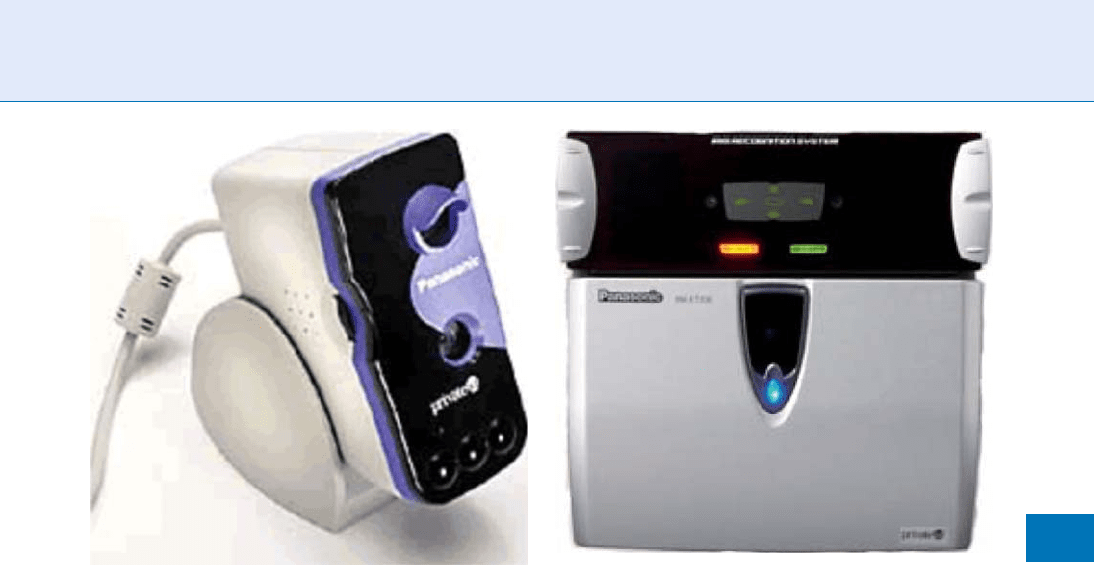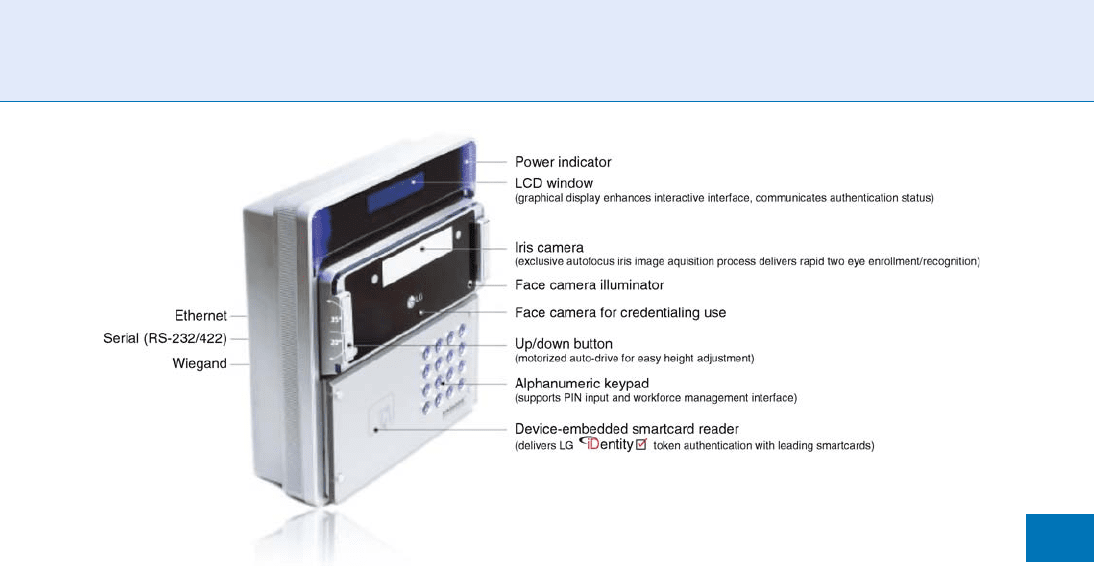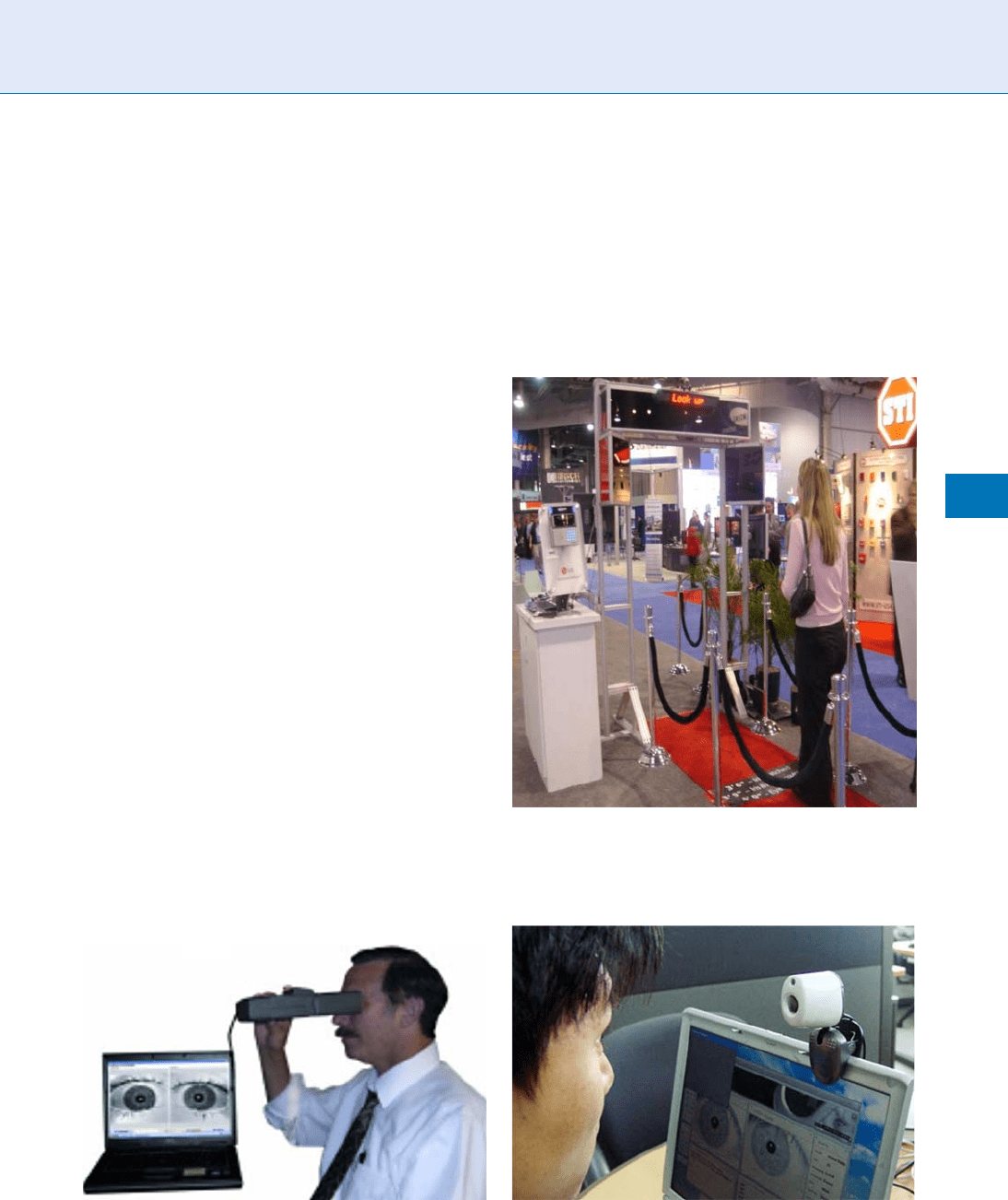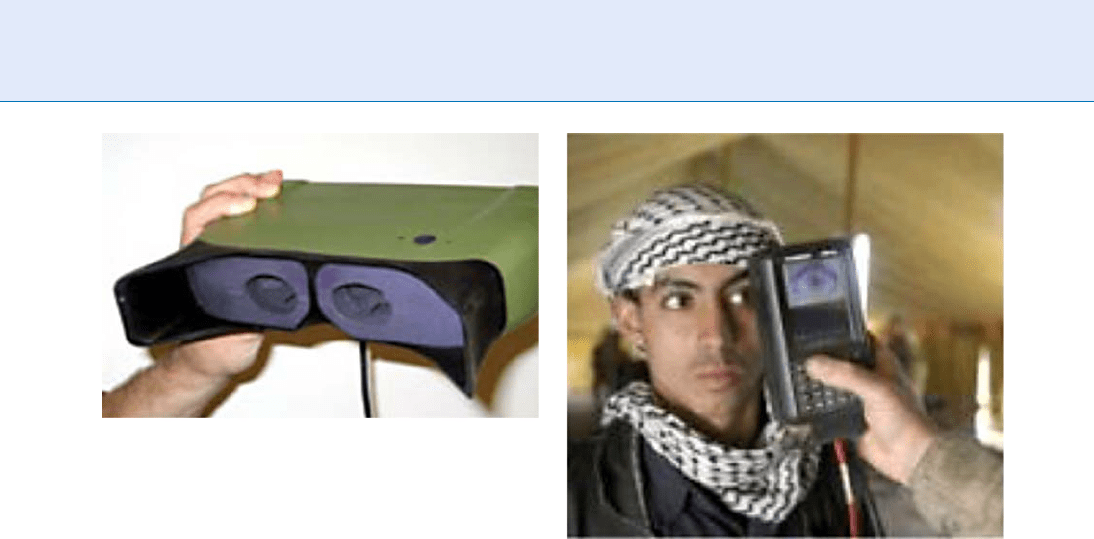Li S.Z., Jain A.K. (eds.) Encyclopedia of Biometrics
Подождите немного. Документ загружается.


Intrinsic Dimensionality of a
Manifold
Intrinsic dimensionality of a manifold is the minimum
number of param eters necessary to parameterize a
manifold.
▶ Manifold Learning
Intrinsic Direction of Fingerprint
A unique direction that is defined by the global direc-
tion variations of a fingerprint itself. It should be
possible to compute it from different fingerprints of
the same finger.
▶ Fingerprint Features
Intrinsic Distance
Intrinsic distance is the length of geodesic between two
points on a manifold. It is also referred to as geodesic
distance.
▶ Manifold Learning
Intrinsic Failure
Intrinsic failure is the security lapse due to an incorrect
decision made by the biometric system. A biometric
verification system can make two types of errors in
decision making, namely, false accept and false reject.
A genuine (legitimate) user may be falsely rejected by
the biometric system due to the large differences in the
users’ stored template and input biometric feature sets.
These intra-user variations may be due to incorrect
interaction by the user with the biometric system
(e.g., changes in pose and expression in a face image)
or due to the noise introduced at the sensor (e.g.,
residual prints left on a fingerprint sensor). False
accepts are usually caused by lack of individuality or
uniqueness in the biometric trait, which can lead to
large similarity between feature sets of different users
(e.g., similarity in the face images of twins or siblings).
Both intra-user variations and inter-user similarity
may also be caused by the use of non-salient features
and non-robust matchers.
▶ Security Issues, System Design
Invariant–Covariant
A function is invariant under a certain family of trans-
formations if its value does not change when a trans-
formation from this family is applied to its argument.
A function is covariant when it commutes with the
transformation, i.e., applying the transformation to the
argument of the function has the same effect as apply-
ing the transformation to the output of the function.
A few examples may help to explain the difference. The
area of a 2D surface is invariant under 2D rotations,
since rotating a 2D surface does not make it any smal-
ler or bigger. But the orientation of the major axis of
inertia of the surface is covariant under the same
family of transformations, since rotating a 2D surface
will affect the orientation of its major axis in exactly
the same way. Based on these definitions, it is clear that
the so-called local scale and/or affine invariant features
are in fact only covariant. The descriptors derived from
them, on the other hand, are usually invariant due to a
normalization step.
▶ Local Image Features
Iris
The iris consists of muscle tissue that comprises of a
sphincter muscle that causes the pupil to contract and a
group of dilator muscles that cause the pupil to dilate.
The back surface is covered by a layer of pigmented
epithelial tissue. The outer edge is attached to the sclera.
▶ Anatomy of Eyes
▶ Iris Image Data Interchange Formats, Standardization
▶ Template Protection
760
I
Intrinsic Dimensionality of a Manifold

Iris Acquisition Device
RYA N RAKVIC
1
,RANDY BROUSSARD
1
,LAU REN KENNELL
1
,
R
OBERT IVES
1
,ROBERT BELL
2
1
The John Hopkins University, Applied Physics
Laboratory, Annapolis, MD, USA
2
Biometrics Alliance, Severna Park, MD, USA
Synonyms
Iris camera; Iris image capture device; Iris reader; Iris
scanner
Definition
An iris acquisition device is a device that acquires an iris
image and compares and matches it to a collection of
other iris images. Consumer enthusiasm and technolo-
gical advancement have fostered the creation of many
types of iris acquisition devices that vary in many
dimensions. The following essay, surveys and reports
iris acquisition devices that exist in the market today.
Introduction
Today, the popularity of iris acquisition devices is
gaining momentum mainly due to the fact that they
are considered perhaps the most accurate way to iden-
tify a human. In addition, iris acquisition devices have
the ability to accommodate a large group size, return
responses faster than any other security metric, and
adapt and utilize a range of advancing technological
resources.
Many factors help determine the performance and
popularity of an iris acquisition device. The heart of a
device is represented by the
▶ iris recognition algo-
rithm, and the resulting accuracy is evaluated with a
combination of performance metrics, including false
acceptance rate (FAR) and false rejection rate (FRR).
The most popular algorithm in use today was invented
by iris recognition pioneer John Daugman [1]. The
response time of an algorithm is also an important
factor in determining the overall popularity of such
systems.
Like any young technological product, iris recogni-
tion systems have been drastically evolving, driven
both by consumer demands and technological
improvements. Today, a differentiating factor amongst
iris recognition systems is the variance in the product
form.
Current iris recognition systems vary in terms of
size, weight,
▶ focal distance, and hardware and soft-
ware portability. The advancement of technology has
dramatically impacted iris recognition systems, pro-
viding the opportunity to create smaller, more portable
autonomous system s. However, the need for larger and
more powerful traditional systems still exists. For ex-
ample, in an airport setting where space and power are
not limi tations, the primary objective is having the
most secure system possible.
The current deployment of iris recognition systems
ranges from government to industrial to even private
use. Other uses are automated international border
crossing, airport and aviation security, database and
computer access, hospital access, and countless other
private industrial settings. For example, in the UK, five
airports are currently using iris recognition systems for
security. In the United Arab Emirates, the largest sys-
tem is employed to prevent deportees from re-entering
the country illegally, with over ten billion iris compar-
isons performed daily. An in-depth list of deployments
is given by Daugman [2].
This chapter summarizes the key aspects of the iris
recognition systems that are deployed or available for
deployment at the present time. The objective here is
not to perform a rigorous performance analysis of
current iris recognition systems, but to survey and
report on information that is publicly available.
When specific information is not available, comments
are made on the highlights of each iris recognition
system. In par ticular, sufficient information was not
always available to report system performance. Addi-
tionally, knowledge of the recognition algorithm that is
employed by the iris system is not always available.
Besides commenting on the key aspects, the current
deployment of each iris system, including a represen-
tative quotation when appropriate is also highlighted.
Iris Acquisition Devices
The following list of iris acquisition devices is in alpha-
betical order. Table 1 lists the iris products while giving
brief comments about each one. To our knowledge,
this information is comprehensive; however there
may be some products that are inadvertently not listed
below.
Iris Acquisition Device
I
761
I

Authenticam™
The Panasonic ‘‘Authenticam™’’ DT120 is an iris rec-
ognition system that is lightweight, compact, and has
an iris capture distance of 19–21 in. An example is
illustrated in Fig. 1. It utilizes a version of the Daugman
[1] recognition algorithm to make this system highly
accurate. It is des igned to work with a host PC, pre-
venting unauthorized access using what is called
‘‘
▶ Private ID™’’ recognition software.
‘‘The Panasonic Authenticam addresses the core
issues of helping an organization diminish or eliminate
the costs of password management, reduce the risks of
privilege and policy management, and increase the
security of a private key. In addition to providing
security for information access applications, the iris
recognition system camera can be used for video con-
ferencing and online collaboration.’’ [3]
There are multiple product offerings with the
base BM [4] Authenticam™ name. The BM-ET200
Iris Acquisition Device. Table 1 List of iris acquisition devices
Product About
Authenticam™
DT120
Highly accurate, portable, affordable, designed for PC authentication purposes, utilizes the
Daugman recognition algorithm
BM-ET200 Unit works in standalone mode or can be networked with other security devices, recognition
results in 0.3 s, utilizes the Daugman recognition algorithm
BM-ET330 Portable, 5 lbs, 150–183 cm focal distance, dual eye, recognition in less than 1 s provides voice
guidance, utilizes the Daugman recognition algorithm
HIIDE™ Series 4 World’s first hand-held, small and lightweight 2 lbs, 3 ounces, 8’’-10’’ focal distance, multi-modal
enrollment and recognition device, stand-alone or with a PC, utilizes the Daugman recognition
algorithm
Iris642 DSP processor based embedded system, small and lightweight for versatile use
Iris on the Move™ Walk-through portal, extremely low false match rate, ability to identify up to 20 moving subjects
per minute, fewer constraints on users than any other iris recognition system
IrisAccess 4000 Intuitive visual user interface; both eyes are captured virtually simultaneously; multi-factor
authentication, utilizes the Daugman recognition algorithm
iCAM 4000/4010 Compact, 5 lbs, 10.2–14.2 in. focal distance, low profile, designed with architectural aesthetics in
mind, utilizes the Daugman recognition algorithm
iCAM 4100/4110 Compact, 5 lbs, 10.2–14.2 in. focal distance, includes a keypad accepting up to 10 digit PINs
affording an additional level of two factor authentication, utilizes the Daugman recognition
algorithm
IrisGuard IG-H100 Handheld iris recognition camera with USB interface, 750 g, 12–30 cm focal distance, versatile
design, utilizes the Daugman recognition algorithm
IRISPASS-M Designed to be connected to a PC, 11 lbs, fully automatic, 2-eye, 10–24 in. focal distance, intuitive
user interface, voice guidance, identification is complete in less than 1 s after image acquisition,
utilizes the Daugman recognition algorithm
I SCAN 2 Durable and compact, held directly to eyes, 1 lb, compatible with known iris matching algorithms
HBOX Embedded in ‘‘through-put environments,’’ IR based, unobtrusive, real time, recognizes at a
distance of 1–2 m and in motion at up to 3 m/s
JPC1000 Snaps to your computer, focal distance 15 cm, 80 g
JPC1500 Desktop device, focal distance 30 cm, 400 g
Mobile-Eyes Hand-held tethered dual-iris capture device, weighs 2.8 lbs, held directly to eyes
Neoris 2000 Standard camera system which incorporates the company’s unique stereo camera technology that
captures iris and face images at the same time
PIER-T™ Rugged handheld device that allows the operator to both enroll and identify individuals tethered
to a host PC or laptop, 12 ounces, utilizes the Daugman recognition algorithm
PIER™ 2.3 Rugged hand-held device, 16.5 ounces, 4–6 in. focal distance, enrollment and identification
performed on handheld, utilizes the Daugman recognition algorithm
762
I
Iris Acquisition Device

[4] unit works in standalone mode or can be net-
worked with other security devices. The claim is that
the BM-ET200 has recognition results in 0.3 s. A dif-
ferent model, the BM-ET330, shown in Fig . 2, also
provides recognition in less than 1 s while providing
voice guidance. The BM-ET330 captures both eyes
simultaneously. It can accommodate a range from
150 to 183 cm and weighs approximately 5 lbs. Both
models utilize the Daugman [1] recognition algor ithm.
The performance is scientifically evaluated in an inde-
pendent study performed by the International Biomet-
ric Group [5].
HIIDE™ Series
The HIIDE™ [6] is known as the world’s first multi-
modal hand-held enrollment and recognition device.
Illustrated in Fig. 3 is the small and lightweight
HIIDE™ Series 4. The Series 4 model w eighs only
2 lbs, 3 ounces and the focal distance is 8–10 in. It
employs the highly accurate Daugman 2Pi algorithm
[1]. Because this series was first designed for the US
Department of Defense, it can enroll up to 10,000
biometric portfolios. The HIIDE™ can operate while
connected to a PC. It can also operate fully in
stand-alone mode, therefore not requiring processing
power from a PC. Additionally, it has the ability to
connect to USB devices, including live-scan devices,
passport or card readers or an external keyboard
and mouse.
‘‘The device can operate in extreme and rugged
mobile environments, as well as on a desktop con-
nected to a host personal computer or network. This
makes it ideal for mobile identification of individuals
on the battlefield, at border checkpoint s, in airports, in
detention centers, and for checking individuals against
known watch lists in addition to naval and coast guard
applications.’’ [6]
Iris
The Iris642 [7] is the only known DSP processor based
embedded system. Because of its embedded nature, it
is small, lightweight, and versatile. This system is com-
patible w ith third party cameras and can also work in a
networked LAN. The Iris642, although a small device,
has the ability to do face and iris recognition together.
The Iris642 employs a sophisticated algorithm that has
resulted in very good recognition scores.
‘‘IriTech uses a variable multi-sector analytic meth-
od that selectively utilizes only the good portions of the
captured image. Even if the image of the eye is adversely
Iris Acquisition Device. Figure 1 An example of the
Panasonic Authenticam DT120 iris recognition
system (from http://www.eyenetwatch.com/iris/
panasonic-authenticam.htm).
Iris Acquisition Device. Figure 2 An example of
the Panasonic BM-ET 330 (from http://panasonic.co.jp/pss/
bmet330/en/).
Iris Acquisition Device
I
763
I

affected by eye glasses, contact lenses, tears, eyelids, or
eyelashes, IriTech’s technology can operate with no
discernible performance degradation as long as at
least 50% of the image sectors are good at the time
of registration and at least 25% are good at the time of
identification. Our tests show that the FAR and FRR do
not change in any significant way.’’ [7]
Iris on the Move™
As the name indicates, Iris on the Move™ (IOM ) [8]
provides iris detectio n and recognition at the ‘‘speed of
life.’’ Physically, the system permits a person to walk
through a portal (shown in Fig. 4), with normal walk-
ing speed, for iris detection and capture. It does not
require people to stop or to remove their glasses.
In addition to being the system with the least con-
straints, IOM claims to be an extremely good perform-
er with low false match rates and has the ability to
capture 20 moving subjects per minute . It also captures
and performs recognition on both eyes simultane ously.
IOM has many foreseeable applications.
‘‘IOM provides a practical and valuable solution to
a critical need for security. Transportation facilities can
depend on IOM to expedite safe and secure travel,
while secure facilities such as government buildings,
courthouses, or power plants can count on its reliable
access control to safeguard occupants. From entertain-
ment venues to office buildings, IOM’s fusion of secu-
rity and convenience ensures that the right people are
in the right place.’’ [8]
IrisAccess
The IrisAccess product line has been in existence since
the late 1990s. All IrisAccess [9] products employ the
Daugman [1] recognition algorithm. Specifically, the
IrisAccess 2200 series has been designed for high secu-
rity server rooms, safety deposit boxes, and other top
security areas. As for the level of security, it was pur-
ported to be the best at the time of its release. However,
the IrisAccess 2200 is no longer serviced, and its suc-
cessor is the IrisAccess 3000. The performance of the
IrisAccess 3000 is scientifically evaluated in an inde-
pendent study conducted by the International Biomet-
ric Group [5]. It is currently deployed by the Albany
International Airport.
‘‘After a comprehensive review of existing biomet-
ric solutions, the LG 3000 software and hardware plat-
form were chosen for its proven positive identification
and authentication of individuals gaining access to
secure areas. The technology provides ease-of-use and
an accurate audit trail of ‘who’ opens the doors, not
Iris Acquisition Device. Figure 3 An example of the L-1 HIDE Series 4 (from http://www.llid.com/images/stories/
solutions/hiide_product_sheet.pdf).
Iris Acquisition Device. Figure 4 An example of the
Iris on the Move™ (from http://www.sarnoff.com/
products/iris-on-the-move).
764
I
Iris Acquisition Device

just what card was used to open the doors. The LG Iris
solution has been easily integrated into our access
control system whi ch handles over 1,000 employees
and its performance has promoted [sic]usto
explore increasing the use of the LG iris identification
solution.’’ [9]
The latest and greatest system in this product
line is the IrisAccess 4000, illustrated in Fig . 5. The
key accessories of the recent release of the 4000
include application versatility, integration flexibility,
and enrollment speed. It also captures and recognizes
both eyes simultaneously. As with any product chain
development, the feature set has become more user-
friendly.
‘‘Intuitive visual user interface enables users to
quickly position themselves for enrollment or recogni-
tion as images of both eyes are captured virtually
simultaneously. Audio prompts improve speed
of enrollment and recognition performance while a
motor-driven auto-tilt mechanism makes adjusting
the camera for proper height a simple ‘one touch of a
finger’ proposition.’’ [9]
Included in the IrisAccess 4000 product line is
the iCAM series. The iCAM4000/4010 is designed to
be compact, weighing less than 5 lbs, and the 4010
model can embed a smartcard. The iCAM4000 is ideal
for wall-mount, as it includes a motorized height adjust
and face-badging camera. The operating distance
is between 10.2 and 14.2 in. The iCAM4100/4110, in
addition to the previous features mentioned, also come
available with a keypad and LCD display for real-time
communication.
‘‘Multifactor authentication can also be delivered
by the 16-element keypad that comes standard on the
iCAM4100 unit. The authentication options afforded
by being able to configure iris authentication by left,
right, either or both eyes plus a smartcard token, and
in the case of the iCAM4100, a keypad, are simply
unmatched by any other iris recognition offering on
the market.’’ [9]
IrisGuard
The IrisGuard IG-H100 [10] (see Fig. 6) is a versatile
handheld iris recognition camera that provides a USB
interface, weighing only 750 g. The focal distance is
between 12 and 30 cm. It utilizes the hig hly accurate
Daugman recognition algorithm [1]. It is amen able to
accessories that make it ideal for kiosk or wall mount
applications. The IrisGuard IG-H100 is utilized
around the world in many high-level security venues
including the United Arab Emirates (UAE).
‘‘The UAE interior ministry has claimed continuing
success for its nation-wide iris-recognition network,
which includes the country’s airports in its coverage.
The system, which uses a single-eye H-100 camera
supplied by a UK-based company IrisGuard, was
Iris Acquisition Device. Figure 5 An example of the IrisAccess 4000 (from http://www.lgiris.com/ps/products/
irisaccess4000.htm).
Iris Acquisition Device
I
765
I

introduced in 2003 and has since expanded to include
140 iris-recognition stations in 22 enrollment centers
and 35 land, sea and air border points across the UAE.
The nationwide system has 1.1 million irises stored
in its database, according to the interior ministry, and
has performed 21 million iris searches for 10.5 million
persons over the past 3 years, which makes it the
largest search iris database in the world. Using this
information, the UAE identified 124,435 individuals
who were trying to return to the country illegally
with forged documents after deportation.’’ [10]
IRISPASS
The IRISPASS-M [11] (see Fig. 7), in similar fashion
to its competitors, provides responses in less than 1 s.
It employs the highly accurate Daugman recognition
algorithm [1]. The performance of the IRISPASS-WG
is scientifically evaluated in an independent study per-
formed by the International Biometric Group [5]. The
operational range is approximately 1–2 feet while ex-
amining at a height of 57—78 in., and the system
weighs 11 lbs. The interface is intuitive as it provides
voice guidance. The default model is designed to be
connected to a host PC, and accompanying software
is available. In the product line are IRISPASS models
that connect to mobile phones and personal digital
assistants. Like other devices, the IRISPASS-M is
employed in law enforcement, border control arenas,
and banks.
‘‘Oki Electric Industry Co., Ltd. announced its
delivery of IRISPAS S1-M iris recogn ition cameras
to Pictet & Cie Bank, a private bank in Geneva,
Switzerland. Pictet chose IRISPASS-M to bring the
highest level of security at the entra nces of high pro-
tection room in its newly constructed headquarter
office buildings.’’ [11]
ISCAN
ISCAN 2 [12] is a durable (shown in Fig. 8) and
compact dual iris capture scanner, weighing just over
1 pound. It is designed for both military and civilian
Iris Acquisition Device. Figure 6 An example of the
IRISGUARD IGH100 (from http://www.irisguard.com/
pages.php?menu_id=29&local_type=0).
Iris Acquisition Device. Figure 7 An example of the IRISPASS-M (from http://www.oki.com/jp/FSC/iris/en/m_features.
html).
766
I
Iris Acquisition Device

security programs. Software support is available to
provide active mobile enrollment. It is also compatible
with many known iris matching algorithms. The scan-
ner is ANSI INCITS 379–2004 and ISO/IEC 19794–6
compliant. The ISCAN technology is also embedded
into multi-modal offerings.
‘‘Cross Match will display several other offerings
from its comprehensive product portfolio at the BCC,
such as its
▶ Multimodal Jump Kits incorporating
the ISCAN 2. Jump Kits are used by the military,
law enforcement, and other first responders for rapid
enrollment as well as for local or remote identifica-
tion.’’ [12]
HBOX
The HBOX [13] is a revolutionary device that supports
a continuous flow of 30 people a minute at up to
3 m per second through a portal like structure. It is
multi-modal by recognizing both face and iris. It
allows a person to walk through an area while captur-
ing their iris at a distance of 1–2 m. It is a compact
device that is 48 12 12 in., and can be mounted
anywhere. An illustration is provided in Fig. 9.
JPC
The Jiris JPC1000 [14] advertises a capability to recog-
nize an eye signature in 1 s and includes software to
encrypt or decrypt data. The focal distance is approxi-
mately 15 cm and it weights approximately 80 g. The
device snaps onto the top of a PC, as illustrated in
Fig. 10. The desktop model, the Jiris JPC1500 [14]
weights approximately 400 g and has a focal distance
of 30 cm.
Mobile-Eyes
Mobile-eyes [15][16] is a hand-held tethered dual-iris
capture device illustrated in Fig. 11. The device weighs
2.8 lbs and incorporates proprietary software.
Iris Acquisition Device. Figure 8 An example
of the ISCAN2 (from http://www.crossmatch.com/
I_SCAN_2.html).
Iris Acquisition Device. Figure 9 An example of the
HBOX (from www.hoyosgroup.com).
Iris Acquisition Device. Figure 10 An example of
the JIRIS1000 (from http://www.engadget.com/2006/03/
06/jiris-jpc1000-brings-iris-scanning-home/).
Iris Acquisition Device
I
767
I

‘‘They employed new developments in opto-
electronics and digital signal processing to create an
unprecedented eye biometric system that successfully
exploits the full potential of the eye into a four-
phase solution that captures, collects, stores, and
identifies biometric information. As a transitional or
augmented security option, the Retica system integra-
tes iris information into a multi-modal solution that
co-manages sequential, tightly-coupled retinal and iris
data. Retica’s unique patented technology fuses together
the images of the retina and the iris, thus significantly
facilitating data collection and resulting in higher
accuracy.’’ [15]
Neoris
The Neoris 2000 [17] uniquely captures both iris and
face images simultaneously with its standard camera
system. The uniqu eness is provided by its face posi-
tioning technology and large focal depth. It is easy to
use, and the resulting images are of high quality.
The module is based on IriTech proprietary high-
performance real-time image capture algorithm.
‘‘Virginia-IriTech, Inc. announced that the com-
pany has successfully completed the National Institute
of Science and Technology (NIST) independent Iris
Challenge Evaluation (ICE) 2006 with excellent results.
The NIST ICE tests grant strong independent third
party validation to IriTech core iris identification tech-
nology. Recently the Neoris 2000 was certified by the
Chinese government for sale in China. The Chinese
government test required a FAR of less than or equal to
0.0001%, an FRR less than or equal to 0.05% and an
enrollment error rate of 0.000%. The NEORIS 2000,
running on IriTech algor ithms, easily passed these
tests, achieving an FAR, FRR, and enrollment error
rate of 0.000%. IriTech is the first iris identification
company to achieve this Chinese certification.’’ [17]
PIER™
The PIER™-T [18] is a ‘‘rugged’’ hand-held device
providing both enrollment and identification func-
tions. Operating t ethered to a PC, the device is capable
of storing dual iris information for up to 200,000
individuals. The system weighs only 12 ounces, while
incorporating state-of-the-art lenses, dual-band illu-
mination, a high-resolution video sensor, and a liquid
crystal display screen. The PIER™ performs an image
check, and forwards high-quality images to the host
PC for recognition. The recognition software employs
the industry leading Daugman 2Pi algorithm [1]. This
popular and capable system is employed in a wide
range of locations, incl uding the Department
of Defense (DOD), Biometric Fusion Center (BFC),
the Office of Law Enforcement Technology Commer-
cialization (OLETC), and the Space and Naval Warfare
Systems Command (SPAWAR).
The PIER™ 2.3, illustrated in Fig. 12, handles iris
recognition on the handheld unit. The system weighs
Iris Acquisition Device. Figure 11 An example of the
MobileEyes (from www.retica.com).
Iris Acquisition Device. Figure 12 An example of the
PIER 2.3 (from http://www.securimetrics.com/solutions/
pier.html).
768
I
Iris Acquisition Device

only 16.5 ounces with a focal distance of 4–6 in. It has
also been utilized for security purposes.
‘‘The PIER™ 2.3 has been incorporated into
the Biometric Application Toolset (BAT), a multi-
biometric security platform developed by the US Army ,
Battle Command Lab. The BAT is being distributed to
the Na vy, Marines, Army, and other DOD and non DOD
agencies. The PIER™ 2.3 is also a critical component in
the Rapid Deployment Force ‘ ‘Jump Kit.’ ’ [18]
Conclusions
Iris acquisition devices continue to grow in popularity,
driven mainly by their extraordinarily high accuracy.
While the companies that produce these systems have
adapted to the desires of their consumers, the ever-
changing marketplace has caused these companies to
produce a wide range of products that vary in many
dimensions. As can be seen with the list above, current
iris recognition systems vary in terms of accuracy,
size, weight, focal distance, form factors, hardware
and software portability, and most importantly, cur-
rent deployment. As computer and camera technology
continues to improve and consumer demand con-
tinues to evolve, it is expected that future iris recog-
nition systems will become more accurate, smalle r,
and more portable causing a large increase in future
deployment.
Related Entries
▶ Iris Device
▶ Iris on the Move™
▶ Iris Recognition System Deployments
▶ Overview
▶ Performance Evaluation
▶ Performance Measures
▶ Performance Testing Methodology
▶ Standardization
References
1. Daugman, J.: How iris recognition works. In: Proceedings of the
IEEE International Conference on Image Processing (ICIP),
Rochester, New York (2002)
2. Daugman, J.: 17 December 2007. http://www.cl.cam.ac.uk/
jgd1000/
3. Eyenetwatch.: 17 December 2007. www.eyenetwatch.com/iris/
panasonic-authenticam.htm
4. Panasonic: 17 December 2007. www.panasonic.com/business/
security/home.asp
5. International Biometric Group: 17 December 2007. www.bio-
metricgroup.com/reports/public/ITIRT.html
6. L-1: 17 December 2007. http://www.l1id.com/images/stories/
solutions/hiide_product_sheet.pdf
7. Iritech: 17 December 2007. www.iritech.com/product_1-1.htm
8. Sarnoff: 17 December 2007. www.sarnoff.com/products/iris-
onthe-move
9. LG Electronics: 17 December 2007. http://www.lgiris.com/ps/
products/index.htm.
10. Irisguard: 17 December 2007. www.irisguard.com
11. OKI: 17 December 2007. http://www.oki.com/jp/FSC/iris/en/
12. Crossmatch: 17 December 2007. www.crossmatch.com/
I_SCAN_2.html
13. Hoyos Group: 17 December 2007. www.hoyosgroup.com
14. Retica: 17 December 2007. http://www.retica.com/site/compa-
ny/index.html
15. Jiris: 17 December 2007. www.jiristech.com
16. Morse, B.G.: CEO Retica Systems, ‘‘Product Availability.’’ Email
to Ryan Rakvic. 26 November 2007
17. Iritech: 17 December 2007. http://www.iritech.com/
18. L-1: 17 December 2007. www.l1id.com
Iris at a Glance
▶ Iris on the Move™
Iris Biometric
▶ Iris Recognition, Overview
Iris Camera
▶ Iris Acquisition Device
▶ Iris Device
Iris Camera
I
769
I
